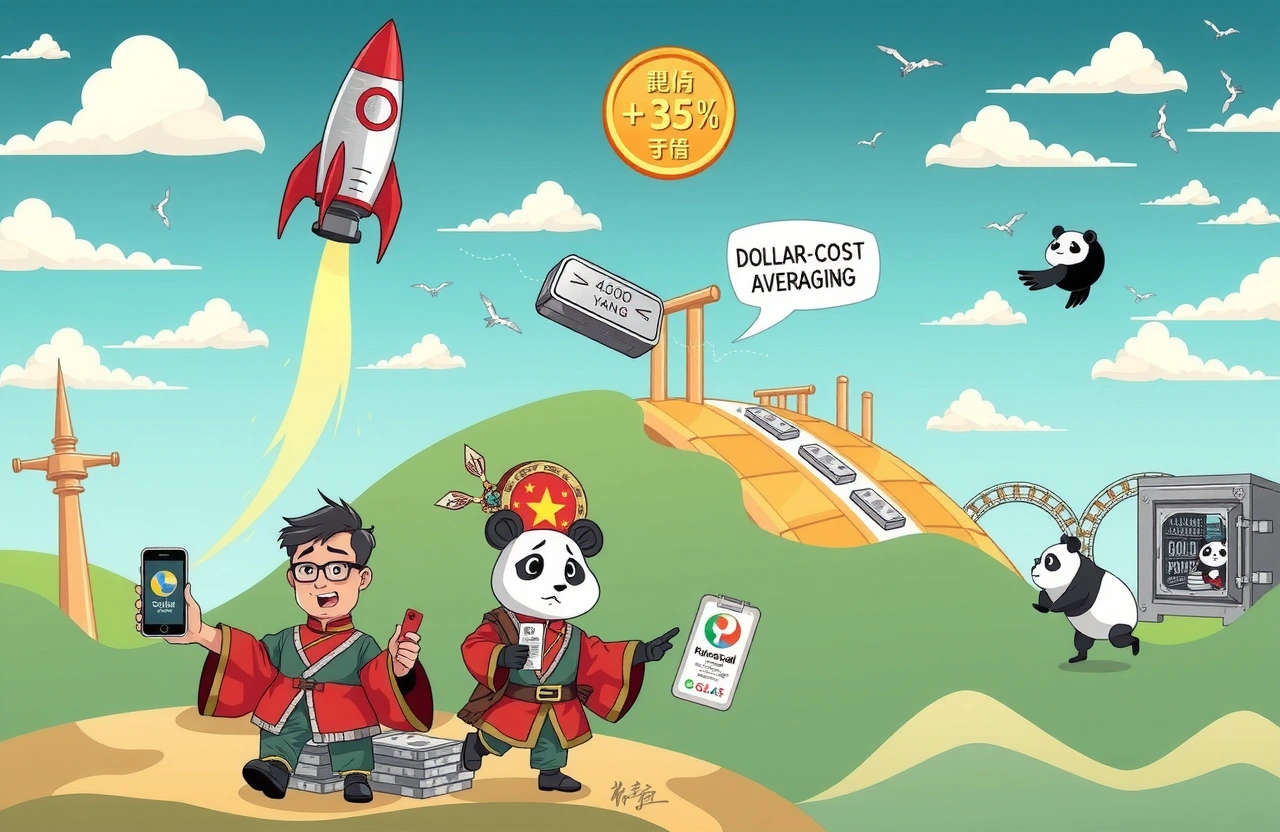Key Highlights
- Silver prices surged 35% year-to-date, outperforming gold’s gains and reaching 14-year highs
- Major Chinese banks including ICBC and Bank of China aggressively market silver bullion, coins, and jewelry
- Physical silver demand lags gold despite price surge due to storage challenges and high volatility
- Tight supply conditions and industrial demand create 4,000-ton market deficit
- Analysts see continuing upside potential but warn of significant price swings ahead
The Silver Rush Is On
The precious metals rally isn’t just about gold anymore. Silver has emerged as 2024’s star performer, skyrocketing 35% year-to-date and decisively outperforming its more famous yellow counterpart. On July 14, London silver spot prices breached $39/ounce – a level unseen since 2010 – confirming silver’s breakout moment. This remarkable surge reflects renewed investor confidence and shifting market dynamics where silver outperforms gold during economic transitions. Banks worldwide now leverage this momentum through targeted silver product launches, transforming the investment landscape.
Banks Capitalize on Silver’s Momentum
Aggressive Product Rollouts
Chinese financial institutions dominate silver investment offerings. Industrial and Commercial Bank of China (ICBC) features silver prominently in its app, promoting items like 50g “Fortune Blessing Silver Ingots” alongside commemorative panda coins with sales exceeding 7,000 sets. Bank of China markets three silver bar collections featuring traditional motifs, priced from $82 to $550. Meanwhile, China Merchants Bank entices buyers with artistic silver jewelry lines. This coordinated push positions silver investment products directly alongside gold offerings across digital banking platforms.
Demand Reality Check
Despite aggressive marketing, branch-level sales diverge significantly from online enthusiasm. “Gold products still dominate physical purchases,” notes a state bank employee. “I’ve received some silver inquiries, primarily about paper investments.” Investor Zhang Jie (张婕) shares: “I rushed to my bank seeking silver options but left disappointed – they offered physical products but no accessible investment vehicles.” This paradox underscores silver’s challenge in matching gold’s straightforward investor pathways.
Understanding Silver’s Investment Profile
The Volatility Factor
Silver trades with significantly higher volatility than gold, a characteristic stemming from its smaller market size and diverse usage cases. Gao Jie (高洁), a commercial bank branch manager, explains: “A $10,000 investment yields about 18 ounces of gold but over 380 ounces of silver – creating storage and preservation complexities.” Former paper silver trading options offered price exposure without physical handling but were discontinued due to regulatory concerns, leaving investors with primarily physical assets.
Practicality Concerns
Unlike gold’s status as a pure monetary metal, silver straddles investment and industrial categories. Industrial applications consume over 50% of annual supply – a dynamic that injects manufacturing demand cyclicality into pricing. Silver also tarnishes faster than gold, requiring specialized storage. As Zhao Jie recounts: “Holding substantial physical silver seems impractical without liquid financial alternatives.” This friction may explain why banks haven’t prioritized stocking major silver inventory despite promotional efforts.
Drivers of Silver’s Historic Surge
Supply-Demand Imbalance
The 2024 silver story pivots on structural scarcity. According to Jinrui Futures analyst Wu Zijie (吴梓杰): “We’re confronting a fifth consecutive annual deficit exceeding 4,000 tonnes.” Exchange-traded funds magnify this tightness – global silver ETF holdings surpassed 1.1 billion ounces in June as investors added 950 million ounces in six months, outpacing 2023 totals. Simultaneously, industrial demand accelerates through solar panels and electronics manufacturing.
Macroeconomic Tailwinds
Silver traditionally rallies when economic uncertainty moderates. Zheshang Futures analyst Yan Mengyuan (严梦圆) observes: “Risk appetite has rebounded since June, with delayed US tariffs easing trade concerns. This rotation favors undervalued metals like silver over defensive gold.” Federal Reserve policy expectations further catalyze momentum – markets currently price in three potential 2024 rate reductions, weakening the dollar and boosting precious metals broadly. Investors have actively traded the gold-silver ratio, selling gold positions to fund silver acquisitions.
Market Outlook and Strategic Considerations
Energy transitions will continue fueling industrial demand, with photovoltaic installations projected to reach 305 GW globally by 2025 – each gigawatt requiring approximately 35 tonnes of silver. Yan maintains: “Gold-silver ratio trading still supports upward potential,” though she warns of amplified volatility as US economic signals fluctuate. Retail investors might explore fractional silver ETFs like iShares Silver Trust (SLV) instead of physical bars. Banks could bridge demand gaps by developing certificate programs allowing silver price exposure through conventional brokerage accounts.
Navigating the New Silver Landscape
Silver’s breakout showcases precious metals extending beyond gold-centric narratives. Banks recognize this shift through accelerated product placements yet face adoption barriers in physical investment channels. With Fed policy fluidity and industrial consumption increasing, silver’s runway appears substantial – but requires sophisticated risk management due to amplified price swings. Investors should scrutinize fees, liquidity, and storage solutions before participation, while institutions must prioritize accessible entry points beyond strictly physical formats. Monitor quarterly mining production reports for rebalancing signals and consider dollar-cost averaging during corrections to capitalize on silver’s unique position in global markets.




